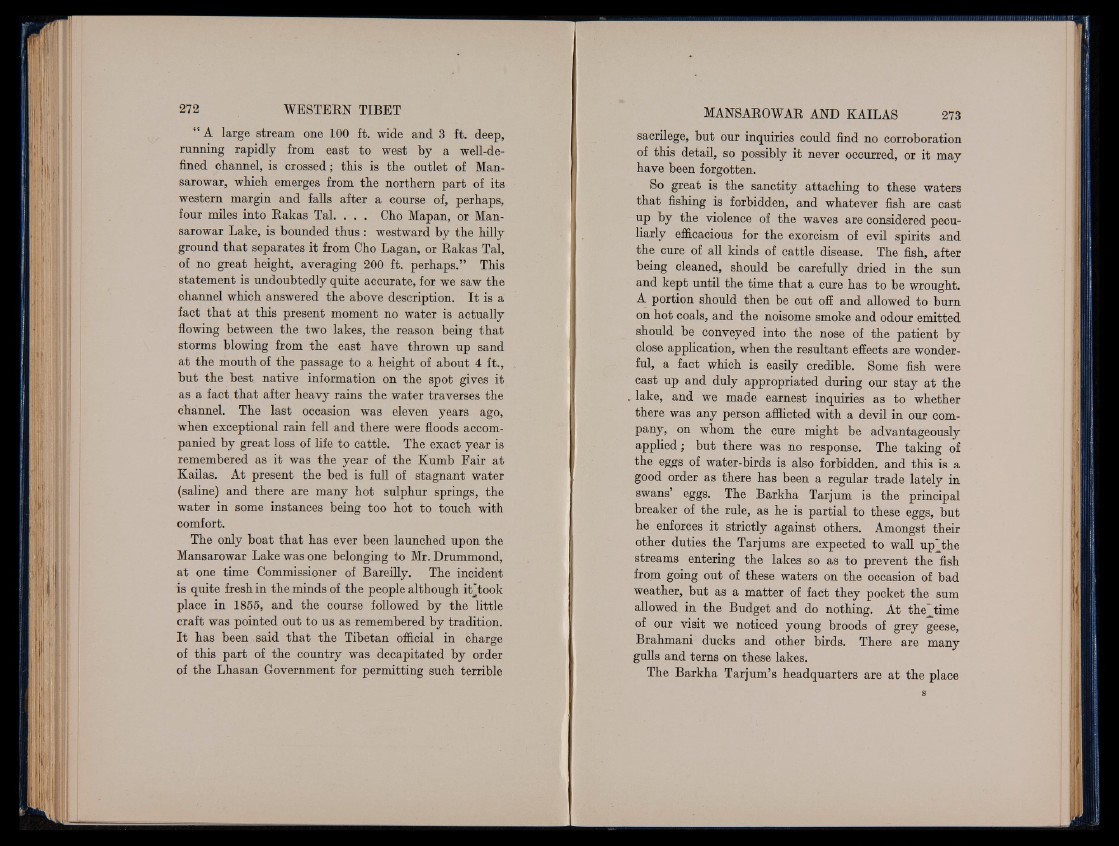
“ A large stream one 100 ft. wide and 3 ft. deep,
running rapidly from east to west by a well-defined
channel, is crossed; this is the outlet of Man-
sarowar, which emerges from the northern part of its
western margin and falls after a course of, perhaps,
four miles into Rakas Tal. . . . Cho Mapan, or Man-
sarowar Lake, is bounded th u s : westward by the hilly
ground that separates it from Cho Lagan, or Rakas Tal,
of no great height, averaging 200 ft. perhaps.” This
statement is undoubtedly quite accurate, for we saw the
channel which answered the above description. I t is a
fact that at this present moment no water is actually
flowing between the two lakes, the reason being that
storms blowing from the east have thrown up sand
at the mouth of the passage to a height of about 4 ft.,
but the best native information on the spot gives it
as a fact that after heavy rains the water traverses the
channel. The last occasion was eleven years ago,
when exceptional rain fell and there were floods accompanied
by great loss of life to cattle. The exact year is
remembered as it was the year of the Kumb Fair at
Kailas. At present the bed is full of stagnant water
(saline) and there are many hot sulphur springs, the
water in some instances being too hot to touch with
comfort.
The only boat that has ever been launched upon the
Mansarowar Lake was one belonging to Mr. Drummond,
at one time Commissioner of Bareilly. The incident
is quite fresh in the minds of the people although it^took
place in 1855, and the course followed by the little
craft was pointed out to us as remembered by tradition.
I t has been said that the Tibetan official in charge
of this part of the country was decapitated by order
of the Lhasan Government for permitting such terrible
sacrilege, but our inquiries could find no corroboration
of this detail, so possibly it never occurred, or it may
have been forgotten.
So great is the sanctity attaching to these waters
that fishing is forbidden, and whatever fish are cast
up by the violence of the waves are considered peculiarly
efficacious for the exorcism of evil spirits and
the cure of all kinds of cattle disease. The fish, after
being cleaned, should be carefully dried in the sun
and kept until the time that a cure has to be wrought.
A portion should then be cut off and allowed to burn
on hot coals, and the noisome smoke and odour emitted
should be conveyed into the nose of the patient by
close application, when the resultant effects are wonderful,
a fact which is easily credible. Some fish were
cast up and duly appropriated during our stay at the
lake, and we made earnest inquiries as to whether
there was any person afflicted with a devil in our com-
pany, on whom the cure might be advantageously
applied; but there was no response. The taking of
the eggs of water-birds is also forbidden, and this is a
good order as there has been a regular trade lately in
swans’ eggs. The Barkha Tarjum is the principal
breaker of the rule, as he is partial to these eggs, but
he enforces it strictly against others. Amongst their
other duties the Tarjums are expected to wall up^the
streams entering the lakes so as to prevent the fish
from going out of these waters on the occasion of bad
weather, but as a matter of fact they pocket the sum
allowed in the Budget and do nothing. At the” time
of our visit we noticed young broods of grey geese,
Brahmani ducks and other birds. There are many
gulls and terns on these lakes.
The Barkha Tarjum’s headquarters are at the place